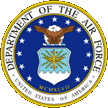BIOGRAPHY
MAJOR GENERAL ROBERT R. ROWLAND
UNITED STATES AIR FORCE
Retired - 1 JUNE 1968
Major General R. Rowland retired as Chief of Staff, Tactical Air Command, Langley Air Force Base, VA.
General Rowland was born in Lodi, Ohio in 1917. He graduated from Lodi High School in 1935; attended Ohio State University of Maryland, majoring in sciences. He entered the Army Air Corps at Fort Hays, Columbus, Ohio in January 1938, followed immediately by assignment to primary flying school, Randolph Field, Texas, and graduated from pursuit course at Kelly Field, Texas, 1 February 1939.
The general's first assignment was with the 94th Pursuit Squadron, 1st Pursuit Group, Selfridge Field, Mich. He was transferred to the 16th Pursuit Group, Albrook Field, Canal Zone, where he successively held duties as tactical pilot, squadron adjutant, squadron armament and groupd armanment officer, base ordance and base chemical warfare officer. In September 1941, he returned to the United States and was assigned as flight instructor and squadron operations officer, Air Corps Advanced Flying School, Craig Field, Ala. In December 1941, he was transferred to Tuskegee Army Flying School, Tuskegee, Ala, where he held positions as director of advanced training and director of fighter training until February 1943.
In February 1943, he was transferred to the 348th Fighter Group, Providence, R.I. as group executive officer. In May 1943 he accompanied that group when it was deployed to New Gujinea - the first P-47 group assigned to the Southwest Pacific. He assumed command of the 348th Fighter Group in November 1943, and held that position until his return to the United States in June 1945.
During World War II, he flew 203 combat missions totaling 400 combat hours and became an ace by destroying eight confirmed enemy aircraft. He participated in nine major campaigns in the New Guinea, Philippines, Solomon Island and the South China area, where his unit specialized in air-ground close support and support of amphibious operations.
During one month of the Philippine campaign, his fighter group dropped a greater tonnage of bombs than any single bomber group in the theater. Ground forces intelligence credited his group with the destruction of more than 10,000 Japanese military personnel during this period. During one phase in which they were concentrating on the air superiority mission, his group shot down 231 confirmed Japanese aircraft in the air while suffering the combat loss of but one of their own pilots.
Upon return from combat, General Rowland was assigned as chief, Tactical Air Force Branch, Tactical Air Force and Joint Training Divison, Continental Air Forces at Bolling Field.D.C. Upon activation of the Strategic Air Command in July 1946, he was assigned as chief, Operations Division and held that position until August 1947 when he was reassigned to the Air Command and Staff School, Maxwell Air Force Base, Ala.
Following graduation from the command and staff school, General Rowland was given a series of instructor assignments at that school, including chief, Plans and Special Operations Branch, and chief, Operations and Intelligence Division. He attended the Air War College at Maxwell Air Force Base, graduating in June 1952.
In June 1952, General Rowland was assigned to the Central Intelligence Agency, Washington, D.C., leaving that organization in April 1953 to assume command of the 21st Fighter Bomber Wing, which was equipped with F-86s at George Air Force Base, California. This was the first tactical F-896 wing to be equipped and trained for special weapons (nuclear) operations. During the following two years, the 21st Fighter Bomber Wing was employed by Tactical Air Command to develop new mobility and forward-rear base concepts to include numerous deployments to Alaska and throughout the continental Unites States. His organization conducted the first jet goodwill tour through the various countries of Central and South America in 1954.
General Rowland accompanied the 21st Fighter Bomber Wing when it departed the United States in December 1954 for a NATO assignment at Chambley Air Base, France, remaining at that station until July 1956 when he was transferred to Ramstein, Germany as deputy chief of staff, operations, Headquarters 12th Air Force. Upon deactivation of the 12th Air Force in 1957, he became the assistant deputy chief of staff, operations, U.S. Force in Europe, and held that position until his return to the United States in July 1958 for further assignment as deputy director of plans for policy, director of plans, Deputy Chief of Staff/Plans and Programs, Headquarters U.S. Air Force. In july 1960 he became secretary of the Air Staff, U.S. Air Force.
In December 1962, General Rowland became chief, Air Force Section, Military Assistance Advisory Group, Vietnam. In this assignment he was charged with the responsibility for planning, programming and training of the rapidly expanding Vietnamese air force, which at the same time, was deeply involved in conducting combat operations against the Viet Cong insurgents throughout the country. During May 1964 the Military Assistance Advisory Group was deactivated and the Air Force Section was redesigned as the Military Assistance Command, Military Asssistance Command, Vietnam. General Rowland continued as chief of the Air Force Advisory Group until he departed Vietnam to become chief of staff, Pacific Air Forces, effective 1 September 1965.
General Rowland was promoted Major General, two-star grade, on 30 April 1965.
NOTE: Colonel Robert N. Baker assumed command of the 21st Fighter Bomber Wing, Chambley Air Base, France in 1956 on General Rowland's transfer to Headquarters, 12th Air Force, Ramstein AB, Germany.

